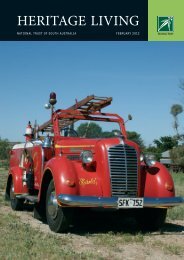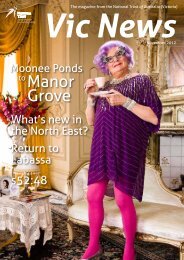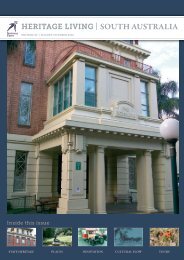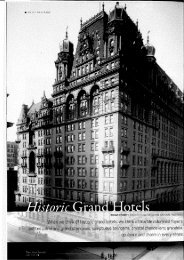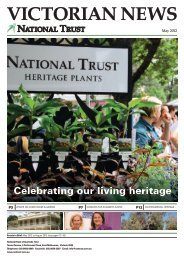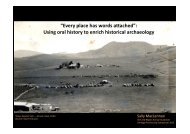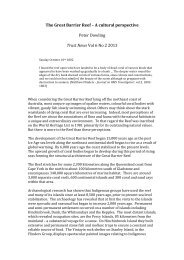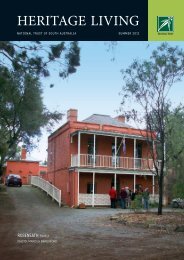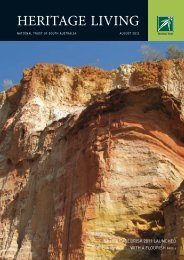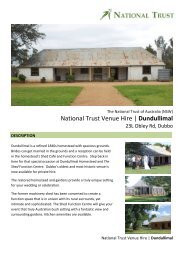HERITAGE LIVING - National Trust of Australia
HERITAGE LIVING - National Trust of Australia
HERITAGE LIVING - National Trust of Australia
You also want an ePaper? Increase the reach of your titles
YUMPU automatically turns print PDFs into web optimized ePapers that Google loves.
Heritage Livingnational TRust <strong>of</strong> South <strong>Australia</strong>STANGATE HOUSE AND GARDENStangate House and garden was bequeathedto the <strong>National</strong> <strong>Trust</strong> <strong>of</strong> South <strong>Australia</strong> bythe late Gwenyth Cornish (nee Thomas) who diedin 1971. The property is managed by the <strong>Trust</strong>and the Camellia Society Adelaide Hills Inc.Mrs. Cornish’s mother , Florence Emily Thomas,who began purchasing the land in 1892, built forherself and her daughter a small wooden summercottage near where the House now stands.The House was named after “Stangate” in Londonsituated at the south end <strong>of</strong> Westminster Bridgewhere the Rev’d Mr Raymond Cornish [Gweynth’shusband] was quartered during a term asHospitaller at St. Thomas’ Hospital, London. TheHouse was planned in London, and a cardboardmodel was made by the Mr Cornish. The plansand model were accepted by Adelaide architect,Mr Eric McMichael, and excavations began on 18thJanuary 1940 when “Mr Tom Shanks and his twogood horses <strong>of</strong>ficiated with plough and scoop”.The builder was Mr J.B. Hughes <strong>of</strong> Prospect.The Cornishes moved in on 1st July 1940. Theyboth derived great joy from developing theirgarden and delighted in the trees and the bird lifethere. The garden was already framed by a variety<strong>of</strong> mature trees, notably the giant English oak treewhich still abuts the shaded walkway known asLovers Lane. It is said that it was planted in 1838by a gold prospector.The Cornishes were responsible for rerouting .Aldgate Creek which ran though their propertyand the stoning <strong>of</strong> the creek walls. Along the creekthey planted masses <strong>of</strong> English blue bells eitherside <strong>of</strong> the paths which they called The Glade. TwoMaple Walks within The Glade were also planted.Mr Cornish’s sister Elsie Marion Cornish helpedwith development <strong>of</strong> the garden. She was regardedas ‘one <strong>of</strong> Adelaide’s best known landscapegardeners, and was responsible for the design andcare <strong>of</strong> many <strong>of</strong> the city’s most beautiful gardens’.Her two significant commissions were theUniversity <strong>of</strong> Adelaide escarpment and the PioneerWomen’s Garden. She was also involved with thedesign <strong>of</strong> the garden at Broadlees, Crafers, the1920s home <strong>of</strong> the Misses Lily and Eva Waite.A tapestry by Mr Cornish on the wall in the housetestifies to the delight both felt for the trees <strong>of</strong> thegarden and the bird life that frequented them.The Adelaide Hills Branch <strong>of</strong> the <strong>Australia</strong>nCamellia Research Society (now the CamelliaCover featureSociety Adelaide Hills Inc.) was invited by the<strong>National</strong> <strong>Trust</strong> <strong>of</strong> South <strong>Australia</strong> to develop aCamellia Garden at Stangate and work started in1977, clearing unwanted vegetation, and plantingsome 400 japonica camellias, 70 reticulatahybrids, 20 non-reticulata hybrids and pottingup 140 varieties. Two steep banks formerlycovered with brambles and bracken were clearedand reinforced with 45 tons <strong>of</strong> walling rock andboulders to form two terraces.An agreement was drawn up between theCamellia Society and the <strong>National</strong> <strong>Trust</strong> in 1980and, on 4 th September 1982, the Stangate CamelliaGarden was <strong>of</strong>ficially opened by the State Ministerfor the Environment, Mr David Wotton. The garden,as seen today, is a testament to many long, hardhours <strong>of</strong> work over the ensuing years by CamelliaSociety volunteers to establish and maintain whatnow is one <strong>of</strong> the best collections <strong>of</strong> camellias inone garden in S.A. and possibly <strong>Australia</strong>.The cost <strong>of</strong> maintaining the garden is not insignificantand the funds generated by the public open dayscontribute a substantial amount to that work.Some <strong>of</strong> the features <strong>of</strong> the garden include:• “Old Oak tree”, which is reputed to be over100 years old and to have grown from anacorn scattered in “homesickness” by adejected English gold prospector. This tree isnow heritage listed,• Commemorative stone and plaqueacknowledges Mrs Cornish’s bequest to the<strong>National</strong> <strong>Trust</strong> <strong>of</strong> SA,• Commemorative plaque acknowledging theinvolvement <strong>of</strong> the Camellia Society AdelaideHills,• Leadwood Garden’s collection <strong>of</strong> 4 very oldcamellias, planted in the late 1800’s andsubsequently moved to Stangate when theoriginal site <strong>of</strong> the nursery was used to widenthe freeway,• Azalea bank,• Miniature camellias near the house,• Japonica walk, Fern walk alongside the creek,• Conifer bed, and• Laburnum arbour.All pine trees were removed from the gardenin 1996 and new areas planted with magnolias,cornus, other exotics, as well as camellias.Refer to page 3 for opening times.page 5



